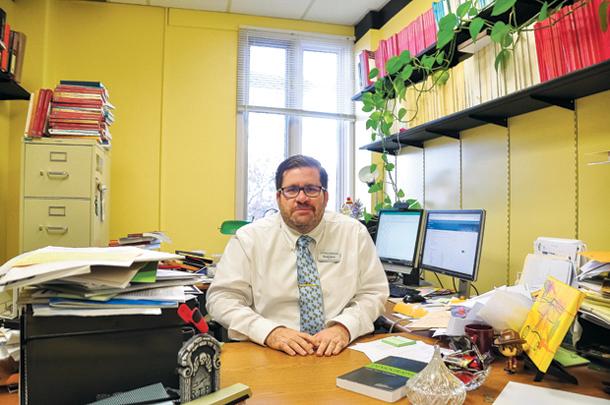Healthcare uncertainty
Dakota Student / Nicholas Nelson
David Flynn is the chair of the economics department at UND.
November 4, 2016
UND professor discusses healthcare premiums spike set to rise in 2017
Healthcare has become a contentious issue in recent years due to the implementation of the Affordable Care Act, commonly known as ObamaCare. Throughout the 2016 election season, healthcare has been a central focus to many of the candidates’ campaigns.
The Affordable Care Act, passed in 2010, is focused on extending healthcare coverage that is affordable to more Americans. It aims to improve the quality of health care and health insurance, and it attempts to help regulate the healthcare industry while simultaneously reducing health care spending.
According to the White House, 20 million more Americans have gained coverage since the law was enacted, and the nation’s uninsured rate now stands at its lowest level ever. Since the Affordable Care Act was enacted, 6.1 million young adults have gained coverage.
President Obama recently announced that a nationwide increase in the costs of premiums will take place in 2017. The cost of health insurance under the Affordable Care Act is expected to rise to a nationwide average of 22 percent. ABC News reports this is approximately triple the percentage increase from 2015-2016, when premiums increased from 7 1/2 percent.
A number of factors have influenced the increase in premiums. Health care is expensive. The cost of medical care and drugs is already high and it continues to increase.
The Affordable Care Act helps more sick people have insurance where they can receive costly treatments they couldn’t afford without insurance. Expensive procedures drive up the cost of premiums.
The Affordable Care Act includes a provision where children are able to stay on their parents insurance plans until age 26. Because of this provision, a number of young people haven’t needed to search for their own plans. A lack of young people is speculated to have partly contributed to the increase in premiums.
Health Insurance companies have hoped younger, healthier people would sign up with ObamaCare to help to balance the costs of the growing older, sicker populations.
David Flynn, a professor in the Economic Department at UND, provided some insight about the rising cost of premiums recently announced by President Obama.
“They are not buying plans,” Flynn said. “Which means the pool does not have the younger, and typically healthier, people in the pool which can lower the overall cost of plans.”
Being covered by a parent’s health insurance plan has impacted the number of young people that would have opted for the Affordable Care Act. The White House says nearly 3 million young people under the age of 26 have been able to stay on their parents’ insurance plans and don’t have to shop for coverage.
However, there are still a number of young people that aren’t covered by their parent’s health insurance who could be affected by the rising premiums.
College seniors going out in the workplace that will be pursuing their own healthcare plans will be affected in different ways, according to Flynn.
“There are still many employers offering health insurance as part of their compensation/ benefits package to employees,” Flynn said. “So if a student is taking a job where health insurance comes as part of the job, this means little to them.”
For students not receiving health insurance through their employers, there is more to think about.
“There are health insurance exchanges where purchases are possible, but some insurers are withdrawing from these, so options are getting to be fewer,” according to Flynn. “There is also the option to pay the penalty amount and not buy insurance. “
Flynn explained how the penalty is lower in cost that buying a plan and paying for medical expenses, in a sense it was not set as a real penalty.
There are still many employers offering health insurance as part of their compensation/benefits package to employees. So if a student is taking a job where health insurance comes as part of the job, this means little to them.
— David Flynn
“As a result, the quality of health in the pool seeking insurance is lower than desirable,” Flynn said. “Meaning higher premiums in order to defray costs.”
NPR has weighed in on how people can maintain a low cost health insurance plan. According to Alison Kodjak., if people pick a low-cost plan with limited benefits and take advantage of all subsidies available, they can find the best deal.
“The government says more than 70 percent of people buying insurance on the marketplaces created by the law could get a health plan for less than $75 a month for 2017,” Kodjak explained.
The White House has made it a central focus to extend coverage to even more of the young, uninsured with hopes of expanding participation in purchasing health care. Focusing on helping students on college campuses, they have enacted White House Healthy Campus Challenge which they describe on their website:
“This challenge aims to engage college and university campuses, and in particular community college campuses, across the country in enrollment efforts.”
A number of factors have contributed to the rise in healthcare costs. However, the exact percentage that rates will increase varies across the country. Depending on where students pursue a job after graduation and whether or not their future employers offer health care coverage will dictate the price of premiums they will pay.
Liz Kacher is a staff writer for The Dakota Student. She can be reached at [email protected]





